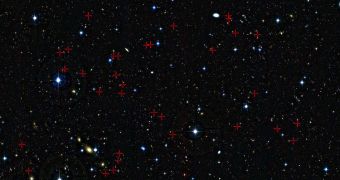A group of astronomers using one of the world's most advanced telescopes announces the completion of a comprehensive survey of the sky, which revealed the eating habits of galaxies as they grow older.
One of the main conclusions was that teenage galaxies, at a point in time between 3 and 5 billion years after the Big Bang, prefer to increase their size by accreting smooth gas flows from their surroundings.
As they grow older, their preference appears to shift from doing this to cannibalizing on other, usually smaller galaxies. Such is the case with our galaxy as well. Evidence suggests that the Milky Way has been through at least three such collisions.
As they increase their size, the cosmic formations become increasingly likely to attract other dwarf galaxies, therefore maximizing their chances of getting yet another meal. This is primarily how they grow to reach their current sizes.
The Universe is filled with large spiral galaxies, and massive, elliptical ones. Astronomers have long since hypothesized that it would have been impossible for these objects to grow so large in just 12 billion years through accretion alone.
The investigation was carried out using the Very Large Telescope (VLT), a complex instrument operated by the European Southern Observatory (ESO), at Cerro Paranal, in Chile. The survey was entitled Mass Assembly Survey with SINFONI in VVDS (MASSIV).
In turn, VVDS stands for the VIsible imaging Multi-Object Spectrograph-VLT Deep Survey. The VIMOS is an advanced camera and spectrograph instrument on the telescope. The VLT is made up of four main observatories, and four secondary ones. It combines light from all of them through a technique called optical interferometry.
“Two different ways of growing galaxies are competing: violent merging events when larger galaxies eat smaller ones, or a smoother and continuous flow of gas onto galaxies. Both can lead to lots of new stars being created,” study leader Thierry Contini, from IRAP, in France, explains.
“For me, the biggest surprise was the discovery of many galaxies with no rotation of their gas. Such galaxies are not observed in the nearby Universe. None of the current theories predict these objects,” adds team member Benoît Epinat.
“To understand how galaxies grew and evolved we need to look at them in the greatest possible detail. The SINFONI instrument on ESO’s VLT is one of the most powerful tools in the world to dissect young and distant galaxies. It plays the same role that a microscope does for a biologist,” Contini adds.

 14 DAY TRIAL //
14 DAY TRIAL //